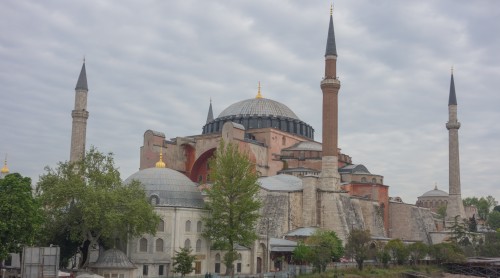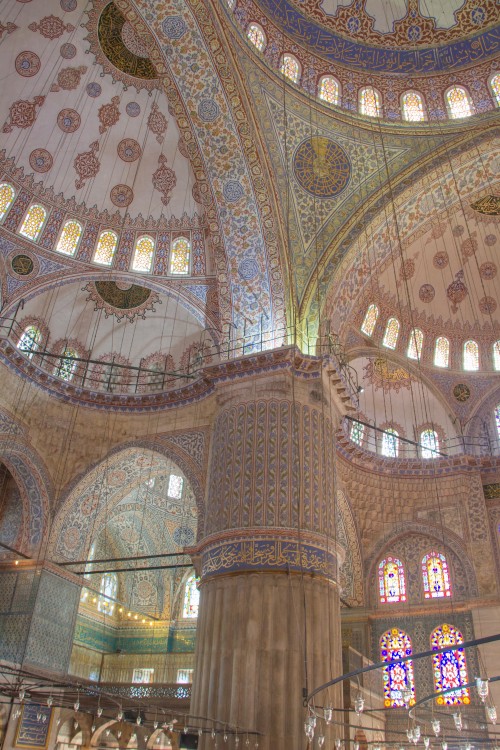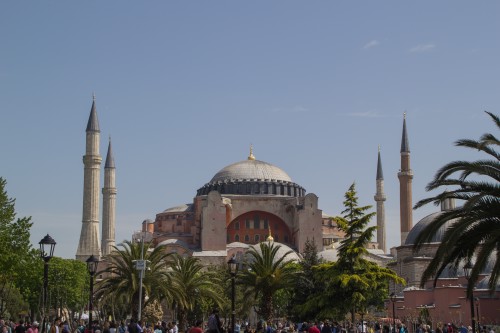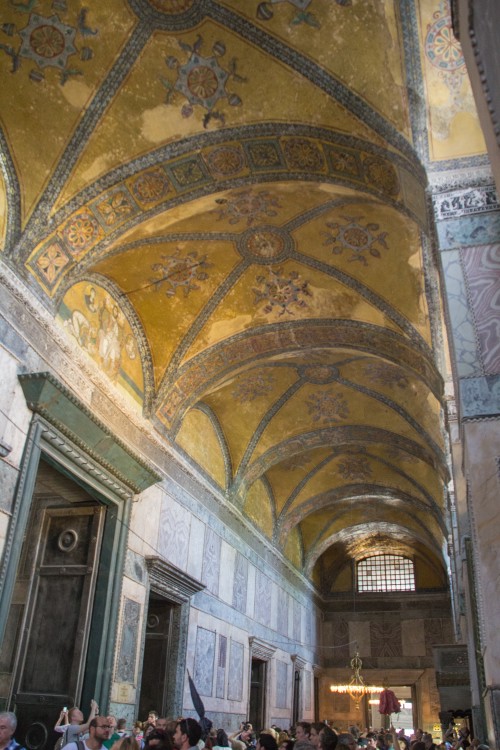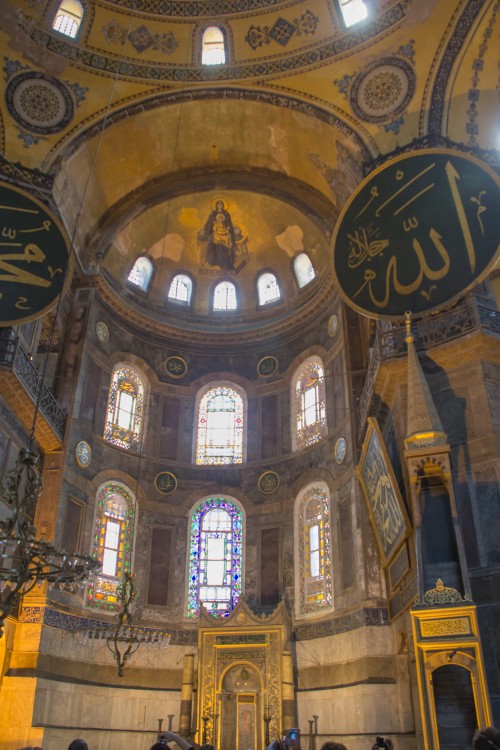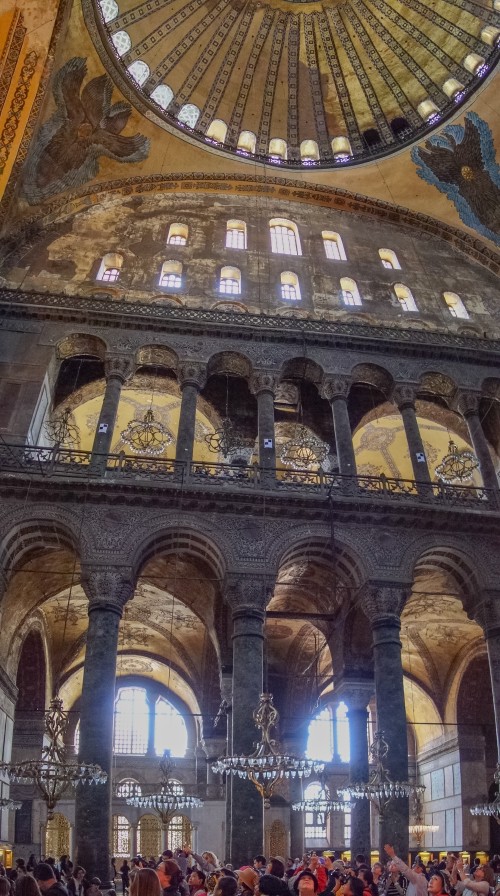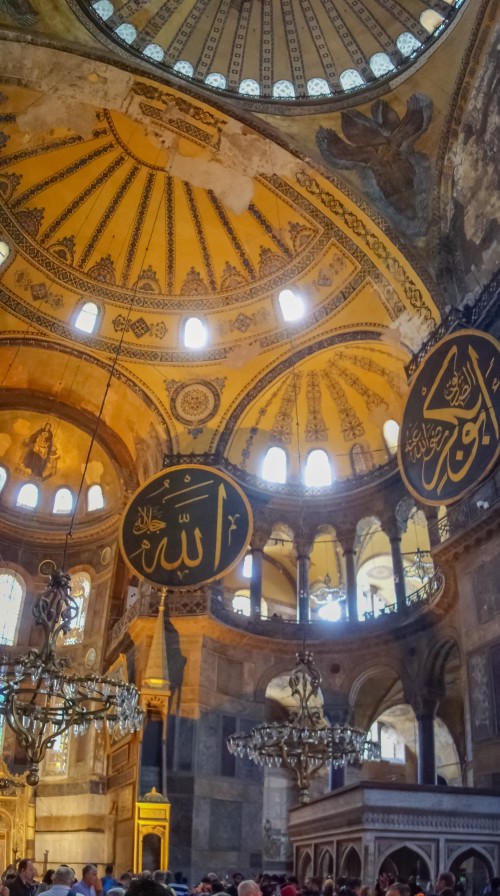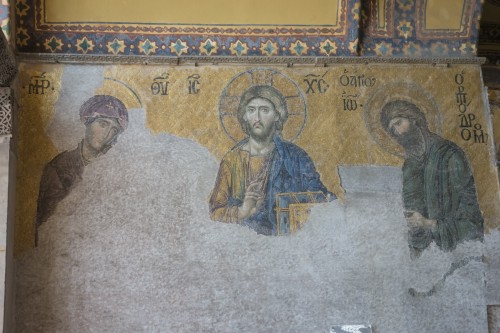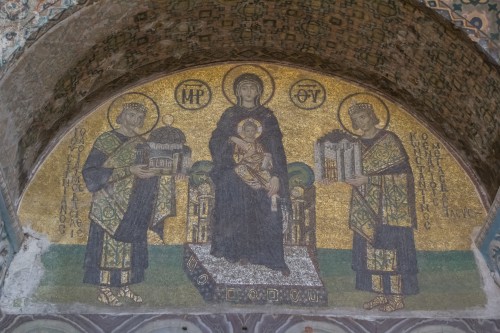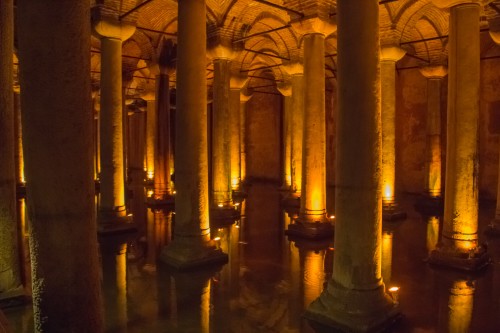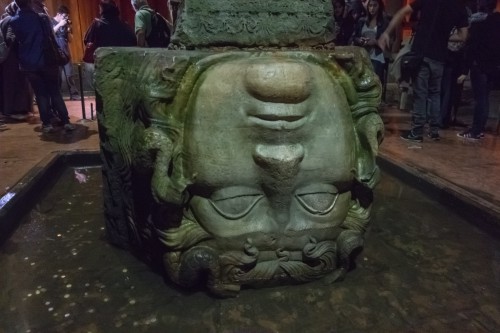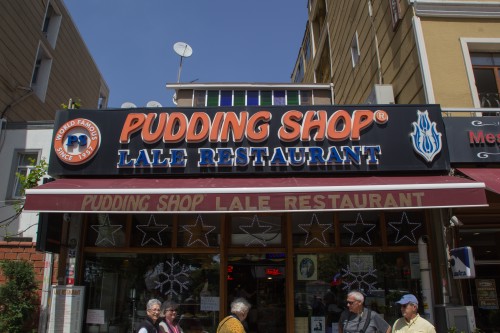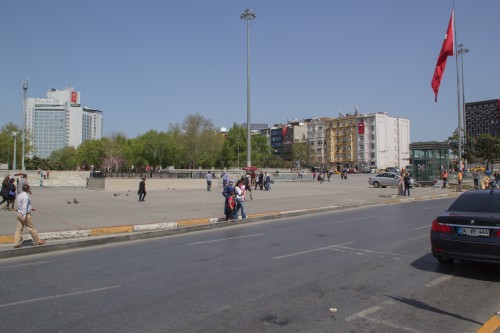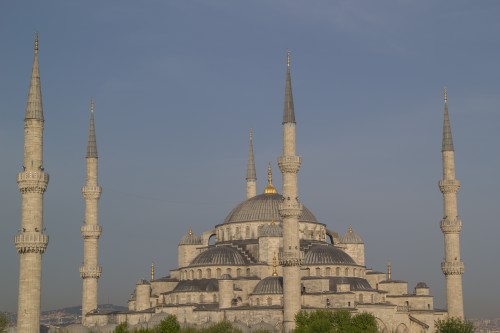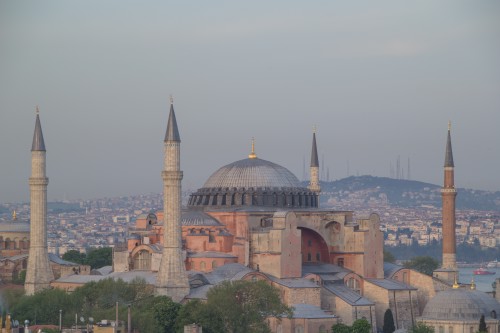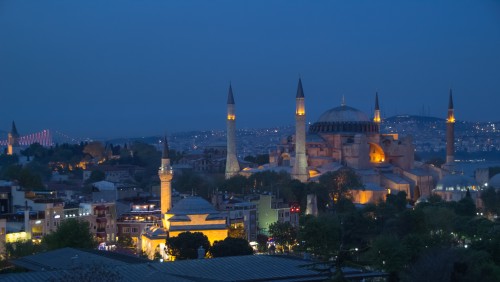We got up at 8, which was the latest in quite some time. The included breakfast was $85, which must be to dissuade non-guests from eating here - we certainly hope it didn't actually cost $85 to us. We met Ezel and left the hotel just after 9am. The streets were fairly empty on east side of everything; Topkapi Palace (northeast of our hotel) not being open on Tuesdays might be why. We turned northwestish up a side street (perhaps Soguk Cesme?), and on our walk Ezel gave us some of the history of Istanbul, from the oldest part of town (where we were) to the newest. Ezel also led us through a small courtyard that had a school for pottery, caligraphry, jewelry, marbling, etc.
 |
We turned left again, and got onto the main drag, and saw tons of people, tons of tour buses - with everyone in a long line for Hagia Sophia. There were probably more people than we'd seen in all of Egypt's tourist sites combined. So instead of starting there, we walked through the Hippodrome, which is now basically just a big courtyard nowadays. There are two obelisks, one from Egypt for Tuthmosis III (which came from Karnak in Luxor, coincidentally) that took forever for the Ottomans to figure out how to erect (nevermind that the Egyptians had erected theirs 3500 years ago), and one built by Ottomans.
We waited in line for a bit, but not too long, at the Blue Mosque (aka Sultanahmet Mosque). The mosque was built in the early 1600s, and contains the tomb of Sultan Ahmet Camii, its founder. The Mosque has one main dome, six minarets, and eight secondary domes. The six minarets is unusual, most have between two and four minarets. The six minarets were a matter of contention and a first, since four minarets were the common maximum. Only after one more minaret was added to the Masjid al-Haram, Grand Mosque, in Mecca, did people stop fretting about the issue. The name "blue mosque" comes from all of the blue tiles used on the interior, and sure enough, there were a littany of blue tiles inside. It was quite full inside, much more than the mosques in Cairo, so we couldn't wander freely, but we got a pretty good idea of the various angles, and then headed out to the northeast.
 |
 |
After exiting the Blue Mosque, we were back in the tourist area between the Blue Mosque and the Hagia Sophia. Ezel indicated there were fountains there, but none of them were on. There were tons of benches around, and a whole bunch of people as well. We meandered over towards the Hagia Sophia, and got in a shorter line, although in hindsight we weren't sure there was a separate line, or whether we and a handful of other people just started it. In our special line, we didn't wait more than about 10 minutes or so. The Hagia Sophia is a full century older than the Blue Mosque, having been started in 537 AD. The Hagia Sophia started as an Eastern Orthodox Cathedral, and then was converted to a mosque in 1453. It remained a mosque until 1931, when it was secularized and turned into a museum. Because of that, the Hagia Sophia includes Christian as well as Muslim art inside. The massive dome inside the Hagia Sophia collapsed in 558 AD (from, among other things, being too flat), and its current form was completed in 562 AD. The dome is 182 feet high, and it is incredible to us that anyone in 562 AD could have built the necessary scaffolding to construct a 182 foot high dome. We walked around the upstairs level for awhile, and saw the famous mosaic of Jesus, Mary, and John the Baptist. We then went downstairs and craned our neck looking up at the various Christian and Muslim decorations going up and up and up.
Our next stop was the underground cistern, which was a very short walk from where we were. It's actually only 500 feet southwest of the Hagia Sophia. It was built in the 6th Century AD to provide water to what was then known as Constantinople. It measures 453 feet by 212 feet, is supported by 336 marble columns, and can hold almost 3 million cubic feet of water. The majority of the columns in the cistern apparently were recycled from the ruins of older buildings from various parts of the empire, together with those that were used in the construction of the Hagia Sophia. They are carved and engraved out of various types of marble and granite. Some of those are very obviously recycled, such as a couple of Medusa heads that weren't even turned right-side up. It was a bit chilly in the cistern, which was a nice change of pace after Jordan and Egypt. We had brought jackets and fleeces in case it was cold in Istanbul (as the weather forecast had predicted), but thankfully it was a very nice temperature outside.
We ate lunch at the Pudding Shop, which became famous in the 1960s as a meeting place for hippies and other travelers on the overland route between Europe and Asia, the "hippie trail." The name "Pudding Shop" got its name from the foreign travelers that could not remember the actual name of the restaurant, but did remember the vast array of puddings sold there. After lunch we went to Taksim Square in the newer part of European Istanbul, site of all the protests in 2013. It was interesting to come to Taksim Square one day after being at Tahrir Square in Cairo - and, fortunately, we didn't have any issues here either. Crystal searched out one of the Starbucks near Taksim Square (there were 2 or 3), and got another travel mug (in Jordan there were no mugs, only travel cups, and she didn't get anything in Egypt).
From Taksim Square, we started walking down Istiklal Street, a pedestrian avenue like Florida Street in Buenos Aires or Rundle Street in Adelaide or 3rd Street in Santa Monica. In addition to a bunch of fancy shops, there were random other buildings on Istiklal like a big church. Ezel took us on a slight detour to Durumzade, a restaurant that we had seen on one of the Anthony Bourdain shows before leaving for our trip. We had just eaten lunch and weren't hungry, but one of the patrons at Durumzade gave us some of his Durum wrap, and it was quite good. We thanked him profusely, and we promised to come back in the evening. We kept walking down Istiklal Street, and went all the way to Galata Tower at the southern end. In hindsight, we should have climbed up to the top, as the view probably would have been great. For whatever reason (likely because we'd been walking for hours) we decided not to climb up to the top; we just wanted to get back to the hotel. The drive back wasn't very long, but took forever because of bad traffic.
 |
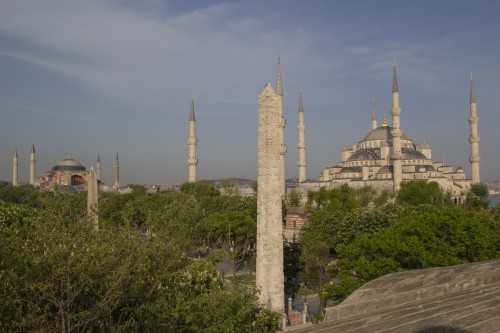 |
 |
 |
 |
 |
With all of the various things we had the ability to do in the afternoon, we ended up deciding on a pub crawl through various rooftop bars. As we had walked around in the morning, we kept seeing restaurants and hotels that we thought would have incredible views, and decided we should try some of them out. Stop 1 was at the Sarnic Teras & Restaurant. It had a nice view of Blue Mosque, but with some sort of pole (maybe a lightning pole) in the way. Stop 2 was at the Hotel Spectra, and had an excellent view of Blue Mosque and Hagia Sophia, with cool windows that opened multiple ways (both an up/down tilt or alternatively swinging open). We could also clearly see the Sea of Marmara. Stop 3 was at the Pierre Loti Roof Restaurant & Bar, and was not as good as the previous stop, because of other buildings being in the way. It had a good view to the north, but there weren't any points of interest that way. It had a fantastic view of the Blue Mosque from the top of the stairs, but alas there were no tables there. But we did see one of the same buildings we saw from the first stop, which looked to have best view, so we went there. Once we figured out exactly where that was - the Hotel Arcadia - it did have an even better view than the second stop, just exceptional really, so we decided to have dinner there as well.
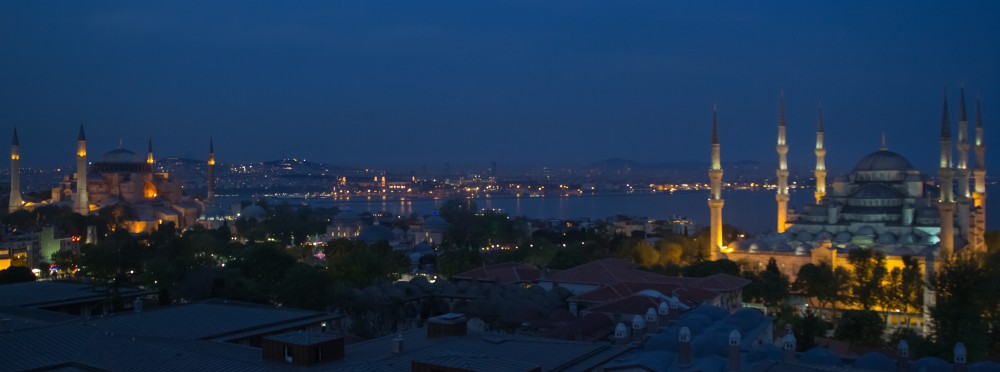 |
 |
 |
 |
Once we finished dinner, we were much more than 3 sheets to the wind (8 or 9?), and meandered around on west side of Hagia Sophia, near the Pudding Shop. We saw the fountains in the courtyard between Hagia Sophia and the Blue Mosque, the fountains that weren't on during the day. We really wanted to get some Durum and/or some Lahmacun (both of which we'd seen on the Anthony Bourdain show), but because of all the bar hopping, we hadn't made it back to Durumzade. So we really wanted to get some Lahmacun, so as we got closer to the hotel, we stopped outside every restaurant to see if they had any Lahmacun, and found one a block or two away that did. Named, perhaps appropriately, the Meat House, we got some Lahmacun and watched the Chelsea-Atletico Madrid Champions League Semi-Final. How we were sober enough to order and pay for our food, we're not sure. But we enjoyed our food, and stumbled back to our hotel to crash for the night.


